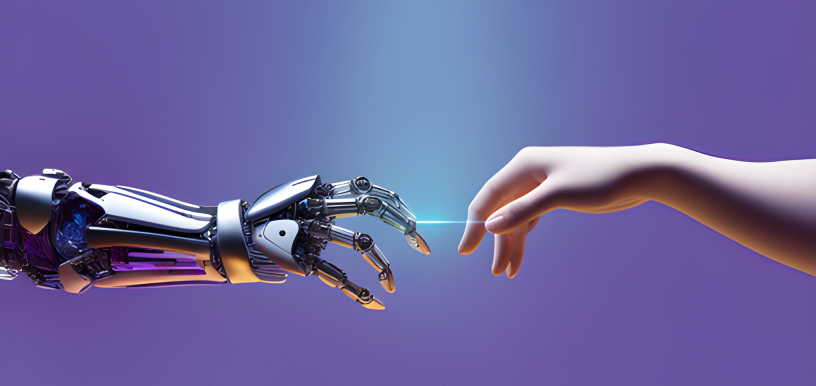AI Chatbots: The Ultimate Guide to Transforming Customer Interactions
Table of contents
Introduction
In today's digital age, Artificial Intelligence (AI) has revolutionized the way businesses interact with their customers. Customer service, in particular, has seen a significant transformation with the integration of AI-driven solutions. While AI brings efficiency and automation to the customer service landscape, it also raises concerns about the loss of the personal touch. Striking a balance between AI and the human element in customer service is essential to ensure that businesses provide effective and empathetic
The Rise of AI in Customer Service
The ascent of AI in customer service is undeniably remarkable. Businesses across the spectrum are swiftly adopting AI-driven solutions to enhance their customer support capabilities. Chatbots, in particular, have become ubiquitous, offering real-time responses to inquiries and serving as a cost-effective means of providing assistance around the clock. These AI applications significantly contribute to customer satisfaction by resolving straightforward issues with speed and precision.
Furthermore, AI has the potential to streamline operations, reduce response times, and increase overall efficiency. However, it is crucial to acknowledge the potential shortcomings of an exclusively AI-driven approach. The challenge lies in balancing automation with the preservation of the human connection.
Knowledge and Skills

To achieve this equilibrium, businesses must invest in comprehensive training and development for their customer service teams. Human agents should be equipped with the knowledge and skills to understand and harness AI effectively, using it as a tool to enhance their performance rather than as a threat to job security.
The Rise of AI in Customer Service
By fostering a cooperative environment between AI and human agents, businesses can create a customer service experience that marries the best of both worlds.
AI and human agents
Human agents should be equipped with the knowledge and skills to understand and harness AI effectively, using it as a tool to enhance their performance rather than as a threat to job security.
To achieve this equilibrium
By fostering a cooperative environment between AI and human agents, businesses can create a customer service experience that marries the best of both worlds.
The Importance of the Human Element
In the quest for efficient customer service, businesses must not lose sight of the intrinsic value of the human element. AI, despite its many merits, cannot replicate the nuances of human emotion, empathy, and creativity. In customer interactions laden with complexity, sensitivity, or unique circumstances, the human touch is irreplaceable. Customers often seek not just solutions to their problems but also understanding and a personal connection. Human agents have the capacity to build rapport, demonstrate empathy, and craft innovative solutions to intricate issues. Neglecting this essential human dimension can result in customer dissatisfaction and the gradual erosion of brand loyalty.
Furthermore, the human touch extends to situations where ethical and moral judgments come into play. Complex decisions, such as exceptions to policy, require human discernment and a consideration of individual circumstances. A machine may not fully understand or weigh the ethical implications of certain actions, while a human agent can navigate these gray areas with care and consideration. This underlines the necessity of preserving the human element in customer service, especially when dealing with ethical dilemmas or situations that demand a personalized and empathetic response.
- In this era of AI-driven customer service, success lies in harmonizing the efficiency of machines with the empathy, adaptability, and ethical judgment of human interaction.
- While the use of AI can streamline operations, save time, and reduce costs, it is essential to remember that customers are not just looking for quick solutions; they are seeking understanding, empathy, and a personalized touch.
- The businesses that master this delicate balancing act will not only thrive in a competitive market but also create customer loyalty that endures the test of time.
Finding the Perfect Balance
Achieving equilibrium between AI and the human touch in customer service is an ongoing challenge but one that can significantly enhance customer experiences. Businesses must make a conscious effort to recognize when to employ AI and when to involve human agents. An effective strategy involves ensuring human agents are readily available for inquiries that necessitate deeper understanding, emotional support, or personalized solutions. They can act as a safety net, ready to step in whenever AI systems are ill-equipped to handle the complexity of a given situation.
Additionally, businesses can enhance AI-human collaboration by training AI systems to work synergistically with human agents. This involves creating a seamless handoff process between AI and human agents, allowing the latter to leverage the data and insights gathered by AI to provide more personalized and informed assistance. By combining the efficiency of AI with the empathy and adaptability of human agents, businesses can elevate the quality of their customer service.
In conclusion, the integration of AI in customer service is a formidable tool that can enhance efficiency and customer satisfaction. Yet, the human touch remains irreplaceable, especially in scenarios requiring empathy, understanding, creative problem-solving, and ethical judgment. Achieving the perfect balance between AI-driven automation and the human element is essential for businesses aiming to deliver exceptional customer service. This harmonious integration ensures that customers receive efficient support while also enjoying the warmth and understanding that only a human touch can provide. As technology continues to advance, businesses that master this balance will stand out as leaders in the era of AI-driven customer service.
Conclusion
The transformation of customer service through AI is an undeniable reality, and the challenges it poses are opportunities for businesses to excel. Striking a balance between the efficiency of AI and the warmth of human interaction is a journey, not a destination. As technology continues to evolve, businesses must adapt their customer service strategies to leverage AI while preserving the human connection.
Subscribe to our newsletter
Never miss out on the latest updates, news, and exclusive content.
